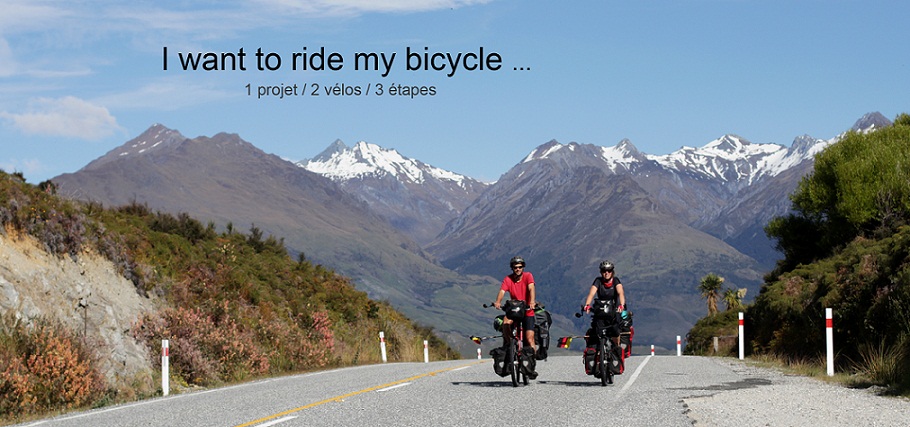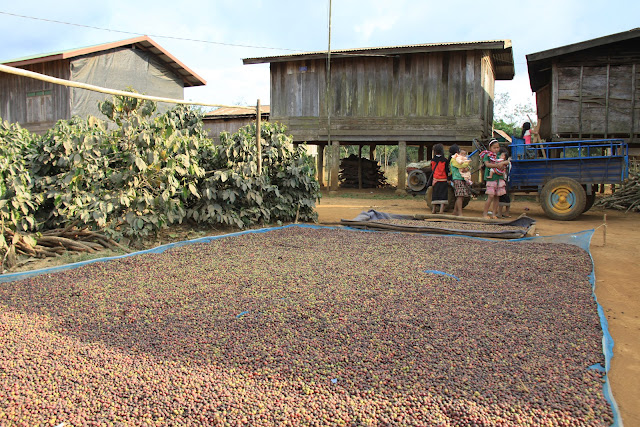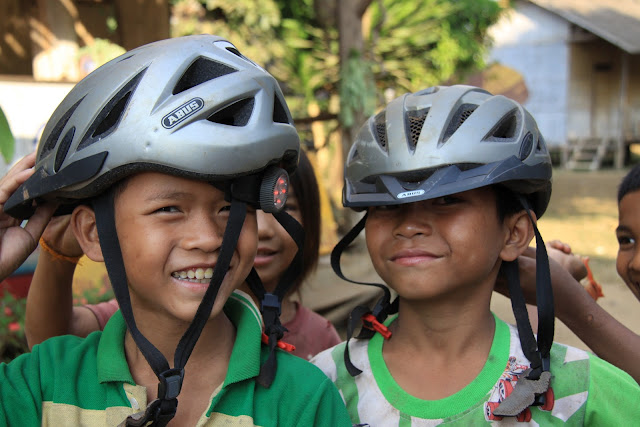A la sortie de Vientiane nous
choisissions pour la première fois de poursuivre en bus sur une portion d’environ
220 km. La route principale est, suivant l’avis de beaucoup, très monotone et
plus fréquentée qu’au nord. En deux secondes et demie, nos vélos sont hissés
sur le toit du bus et sanglés à coté de quelques scooters. C’est « facile,
rapide et bon marché »… et mille fois plus simple et plus sûr que de
prendre le train avec notre amie la SCNB, nous en avons fait l’expérience… Le
bus a cependant ses désavantages, la durée du trajet pouvant varier de
plusieurs heures suivant les marchandises, motos, et autres animaux a charger
et décharger… Le paysage qui défile à travers la vitre confirme notre
choix : pas grand-chose à voir !…
Nous sommes bien contents de remonter
sur nos selles, peu avant Thakek, pour effectuer une boucle de près de 400
kilomètres. Nous quittons à peine la route principale que nous nous tombons brusquement
nez a nez avec de grands massifs montagneux.et retrouvons la joie des
ascensions interminables…
During the dry season in Laos, a large part
of Southern Laos where the rice fields are cultivated is dried up, leaving
large plains of brown grass and hard soil. As you can imagine, cycling a few
hundred kilometers through this area on a busy road which links the north and
the south, is only of limited interest. So we decided that we could spend our
time better discovering other areas and left Vientiane on a bus. It was the
first time we put our bicycles on a bus and we were surprised how easy
everything was – much simpler than what we have experienced taking the train in
Belgium in the past! With a little bit of extra cash and just one quick movement
the bikes were on the roof of the bus and we were ready to leave. The only
downside of taking a bus is that you never know how long the journey takes, it
all depends on how many bags of rice are being picked up on the way or how many
more scooters get strapped on the roof of the bus…
The 220km of scenery we saw from the bus
confirmed our choice of transport, there was not a great deal to see. So we
were even more surprised when we got back on our bikes and turned of the main
road to be surrounded by beautiful limestone karsts. Climbing up a very steep
hill we got to some great viewpoint over the valley.
A Ban Nahin, nous laissons nos
sacoches pour poursuivre un peu plus léger vers Kong Lo et son impressionnante
grotte. La route qui nous y emmène est totalement plate mais se faufile entre
d’énormes excroissances rocheuses parsemées ici et là. La grotte est nichée au
fond de la vallée, seuls quelques pêcheurs nous y attendent pour traverser les
7 kilomètres de rivière souterraine. A bord d’une pirogue en bois, nous nous
engouffrons dans le noir intense de ce labyrinthe enfoui dans la montagne. Le
guide s’oriente à l’aide de sa seule lampe frontale et nous fait voyager d’une
salle à l’autre, leurs parois s’élevant parfois à une centaine de mètres de
haut.
Cette nuit là, au village de Kong
Lo, nous ne pouvons fermer l’œil de la nuit, la musique locale provenant d’une
habitation s’arrêtant vers 6h du matin, au chant des premiers coqs. Nous apprendrons
le lendemain qu’il s’agissait d’une « fête » funéraire pour un homme
du village…
In Ban Nahin we left the majority of our
luggage and cycled much lighter to Ban Konglo, where the famous 7.5km long cave
can be found. Except for the strong headwinds the cycling was easy and
pleasant, the route was completely flat and we passed more limestone rocks
sticking out of the ground. The visit of the cave was very impressive; we
crossed the entire length of it on a small boat with two guides. As expected it
is pitch black in the interior, just a few installed lights highlight the most
spectacular stalagmites and other features. Although the motor of our boat died
on us a few times in the middle of the cave, we didn’t have to swim back in the
dark and we managed to get out of there dry and safe!
Although we were in the middle of nowhere
that night, we didn’t mange to get any sleep at all. The extremely loud music
of a neighboring house stopped at about 6 in the morning, just in time for the
cocks announce a new day with its singing. Unlike our suspicion of a marriage,
it turned out that the village had gathered for a “funeral party” for a man of
the village who had recently passed away.
Au départ de Lak Sao, nous sommes
obligés de faire un détour de plusieurs kilomètres, une bombe ayant été
retrouvée au beau milieu du chemin quelques jours auparavant. Cette région du
Laos est en réalité une des zones les plus minées au monde. Pendant la guerre
du Vietnam, les américains ont bombardé la frontière est du Laos, plus connue
sous le nom de « piste Ho Chi Minh », à défaut d’un bombardement
toutes les 8 minutes pendant 9 années consécutives ! Environ un tiers de
ces 240 millions de mines n’ont pas explosé pendant cette guerre. Mieux vaut ne
pas s’égarer des chemins principaux…
La piste rocailleuse et très
poussiéreuse nous amène au cœur d’un étrange décor d’arbres morts plantés dans
l’eau. C’est surprenant et désolant à la fois. Nous pénétrons en réalité un
immense lac artificiel créé pour le plus grand barrage hydroélectrique d’Asie
du Sud-est, le « Nam Theun 2 ». Ce projet a suscité de nombreuses polémiques,
les retombées économiques pour le Laos étant loin d’être assurées. Il a en tout
cas fait fuir des milliers de
personnes et mit en péril l’écosystème de toute une région lors de l’inondation
de la vallée.
Nous posons nos sacoches au bord
du lac juste avant le coucher du soleil. Nous y rencontrons une bande d’enfants
complètement déjantés… Pendant près d’une demi-heure, ils s’amusent à danser,
jouer, courir comme des fous dans tous les sens sous nos yeux amusés… Etonnant
de voir comment ils gardent le moral, malgré leur environnement dévasté !
After contemplating on what to do next for
a while (difficult road conditions with beautiful scenery versus easy option of
another bus), we finally decided to take on some “Dirt roads” and do the “loop”
as it is called amongst backpackers. This involved going up north to Lak Sao
before heading south again through the Nam Theun National Park to Thakek.
Before we actually hit the Dirt road we
were already confronted with the first problem in Lak Sao: a bomb remaining
from the Secret war in Laos had been found on the middle of the road. Although
we had already read about the so called secret war in Laos (something many
people are not aware of), it was the first time we actually have been
confronted with the reality of it. During the Vietnam war the Americans have
bombed the east of Laos bordering the Vietnam, better known as the Ho Chi Minh
trail, every 8 minutes over the duration of 9 years. It is estimated that about
one third of these 240 million mines did not explode during the war. Although
clearance is taking place (partly financed by the German government) It will
take many years before Laos will be cleared from all these mines. As it is not
uncommon that mines are found today during road works or that accidents occur,
we decided it was best not to adventure of the main roads…
After a detour due to the road blockade, we
finally got on the right road, if that is what you can call the bumpy dirt path
we took. The first day on this road was very difficult, the rocks and remaining
parts of asphalt slowed us down. On the second day the road followed a huge artificial
lake which has been created for a hydroelectric power station. Not only the
road was much better but we also had some stunning views over the lake: the
flooding of the valley has resulted in a bizarre landscape of dead trees in water.
This scenery is impressive and spooky at the same time! Whether the undertaking
of such a project is politically or morally right is another story I will not
go into…






























































